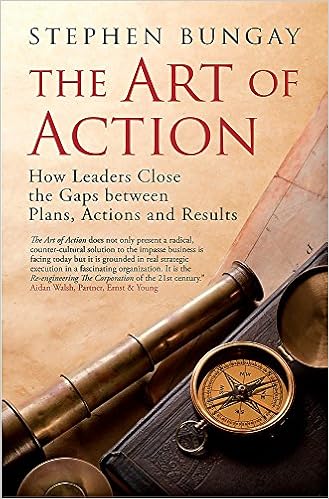 You could fill a large library or perhaps a giant storage unit with all the books that claim to tell you how to adapt the lessons of military leadership and strategy to business. Most of them are long and strong on the military part but skimp on the application to business.
You could fill a large library or perhaps a giant storage unit with all the books that claim to tell you how to adapt the lessons of military leadership and strategy to business. Most of them are long and strong on the military part but skimp on the application to business.
There are books about chest-thumping heroic leadership, with the current fad being for anything that involves the SEALs. And there are hundreds of books that equate war and business. All those books are mostly useless and probably belong in a large dumpster rather than a large library. The Art Of Action is very, very different. It gives you some lessons from the military that you can actually use.
In 2011, I picked this book up as part of the research for a post on what to learn from the military. Now it’s one of my core strategy books. The historical examples are well-told and the writing is excellent. Most important, Stephen Bungay understands both the historical lessons and the business applications. That is rare, indeed.
Early in the book, Bungay notes that in a stable, predictable environment, strategy is relatively easy. We have pretty good knowledge of the challenges. We have a pretty good idea of what actions are available and what effect they will have. But that’s not the environment we face today.
We describe today’s environment with the acronym VUCA for volatility, uncertainty, complexity, and ambiguity. Bungay describes what happens if we do things the old way: “The environment we are in creates gaps between plans, actions, and outcomes.” A little further on, he says:
“There is a model for creating a link between strategy and operations and bridging the three gaps. It involves applying a few general principles in continually changing specific circumstances.”
That’s what the book is about. Here’s a quick overview.
The first chapter of the book is devoted to describing the problem of creating a business strategy in this VUCA environment.
Chapter two is about the causes of “our current unease.” You may be tempted to skip this, but I suggest you don’t. You need this chapter to get the most from the rest of the book.
Chapter three describes how the military got from the army of Frederick the Great to the army described in Team of Teams. The first was the ultimate example of treating soldiers as interchangeable and unthinking parts. Team of Teams is about an organization characterized by trust, transparency, agility, and resilience. By the end of this chapter you will have an idea of the principles that work in a VUCA world and the process the military followed to figure them out.
There are important lessons in the process. If you understand the changes in assumptions and organization that the military went through, you’ll be able to figure out what has t happen for you, where you are.
The next three chapters deal with the three gaps: the knowledge gap, the alignment gap and the effects gap. Bungay makes clear and specific connections between military examples and business applications. This would be an excellent book without this, but these specific connections take the book from excellent to great.
The final chapter of the book is. “Leadership that Works.” It’s about where this approach works and where it doesn’t. It’s about the promise, but also the limits.
Here’s something that’s important. Early in the book, Bungay says that nothing he has to say is new, it is only:
“simply neglected. I have not invented it. I have merely applied it to a domain which uses bits of it from time to time but rarely draws it all together. The insight offered is into the power of getting it right. The value offered is about how to get it right. The practices have been developed through experimentation over a long period, by different organizations in different countries. While they constitute a way of working which was developed to deal with the chaos of battle, they are precisely attuned to the needs of the business environment at the beginning of the twenty-first century.”
In a Nutshell
The Art of Action is a unique book in the world of strategy. It defines and draws on important lessons that the military has learned and (that “and” is critical) it connects them to the world of business in a useable way.
You can check out some of my highlights and notes from this book on my GoodReads page.
-o0o-
What’s the fastest way to learn the big ideas from a great business book? Book summaries. Check out summaries from The Business Source, where you can watch, read, or listen to the big ideas from a great book in under 20 minutes.


There are no comments yet, why not be the first to leave a comment?